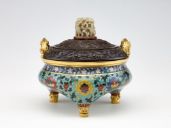Broken Jade
The Jade in this bracelet is broken. The breaking of a jade bangle is considered to protect its wearer by neutralizing evil influences. Due to the material and emotional value, even broken pieces of jade will be treasured. Craftsmen have developed several methods of repair.
There are two main strategies: first, the covering or inlaying of broken pieces with foils made of precious metals after wrapping or stapling the fragments, and second, the replacement of missing parts through carefully crafted elements sculpted out of a glue-like mix made from raw lacquer and rice or wheat flour covered with gold. The latter technique is commonly known in English under its Japanese name as kintsugi. In recent years, gold has been replaced by more affordable gold-colored alloy metals.
Broken or incomplete jade elements were traditionally repurposed. For example, fragments of Neolithic cong jades would be carved into new shapes during later periods (See fig xyz).
](https://micrio.thingsthattalk.net/KCjAD/views/max/128x128.jpg)

](https://micrio.thingsthattalk.net/QauJR/views/max/158x128.png)